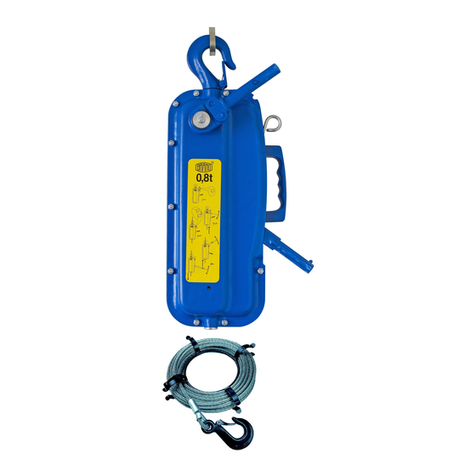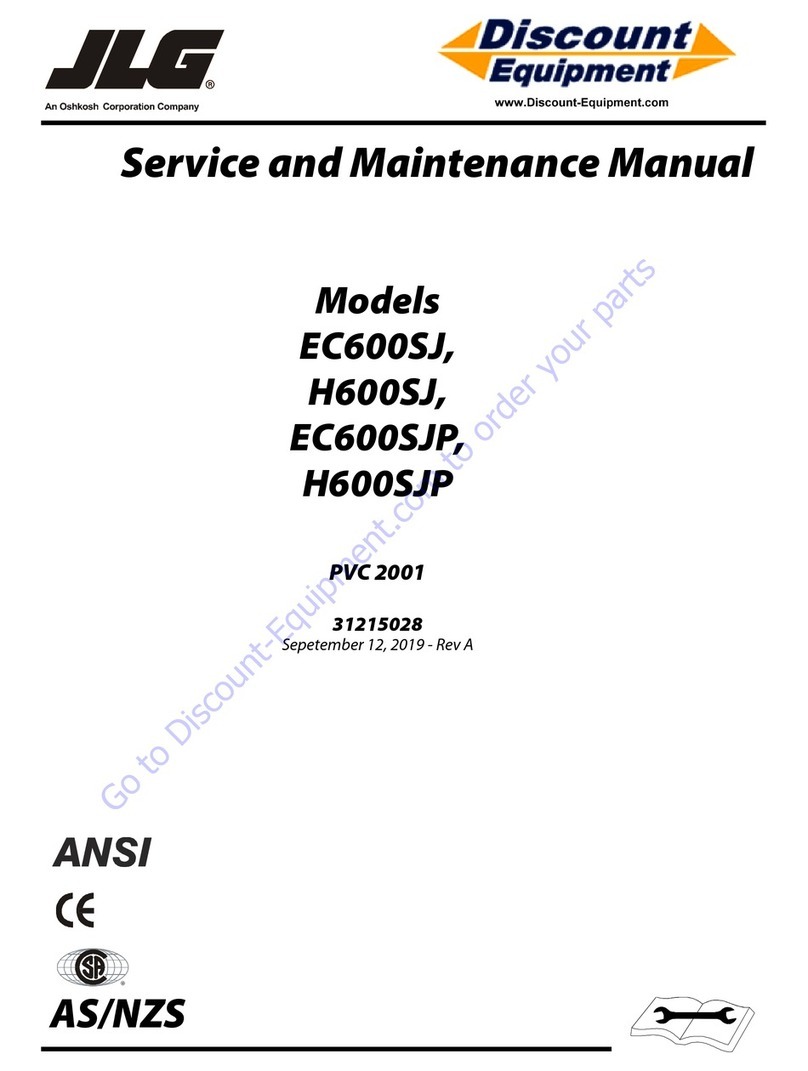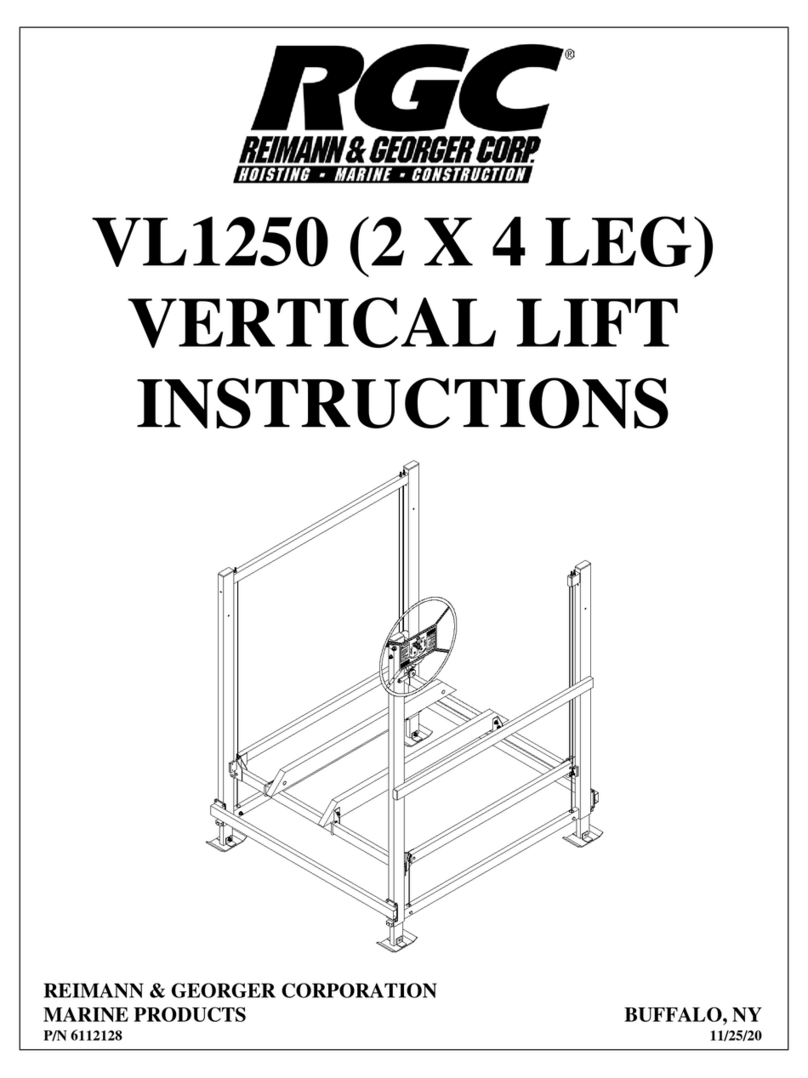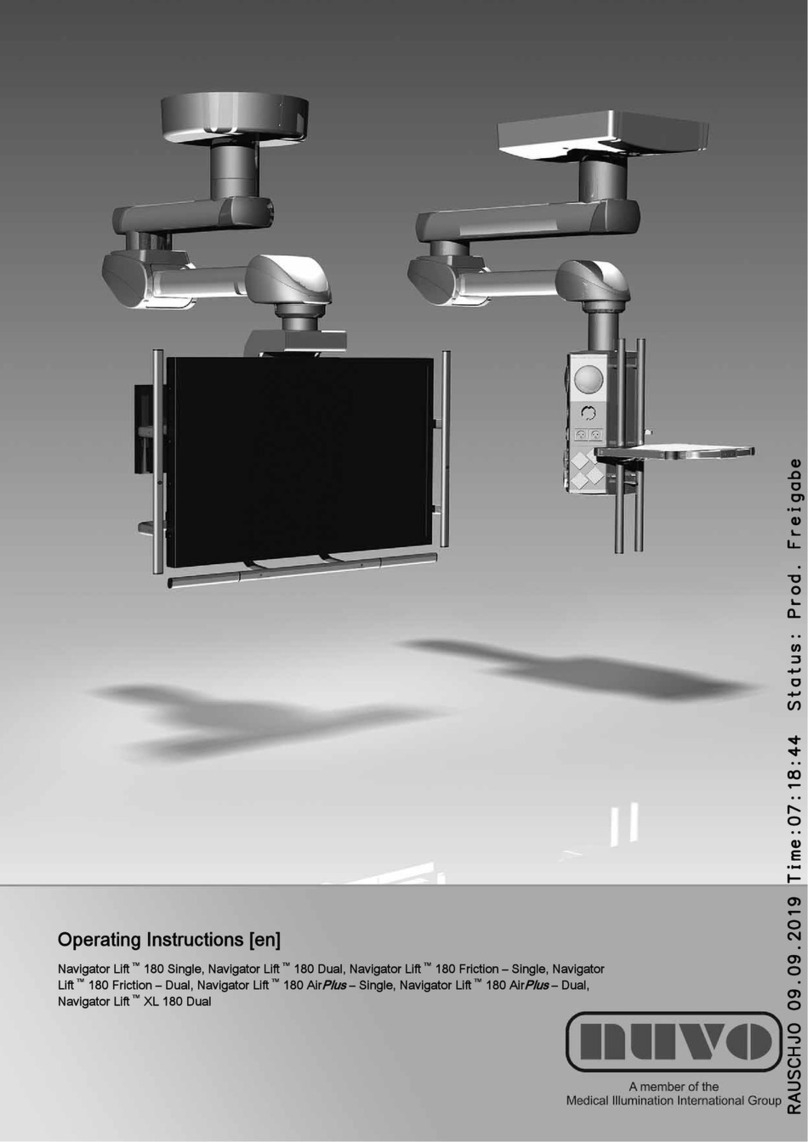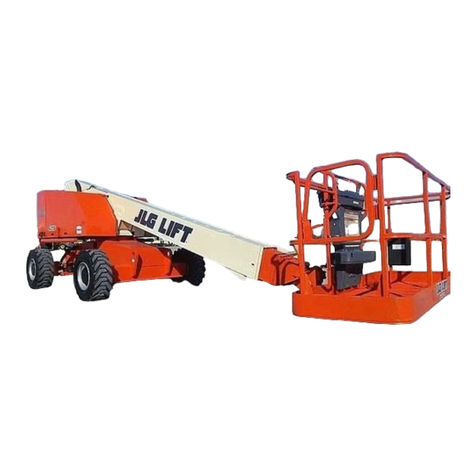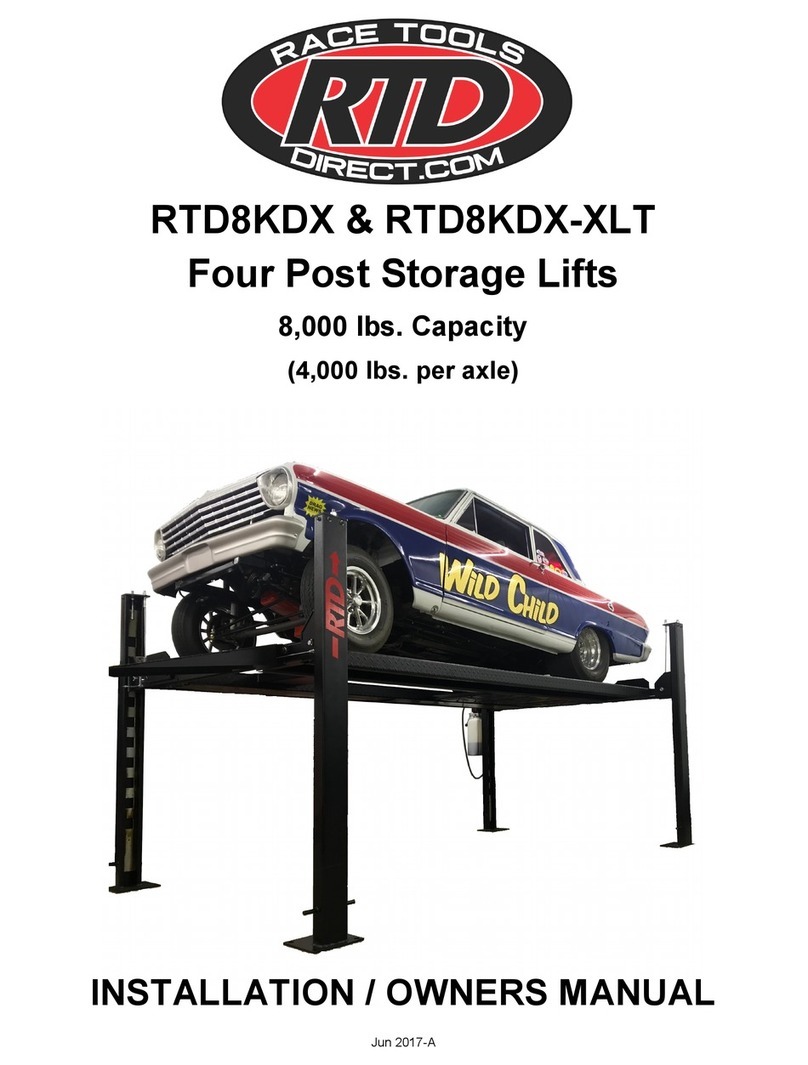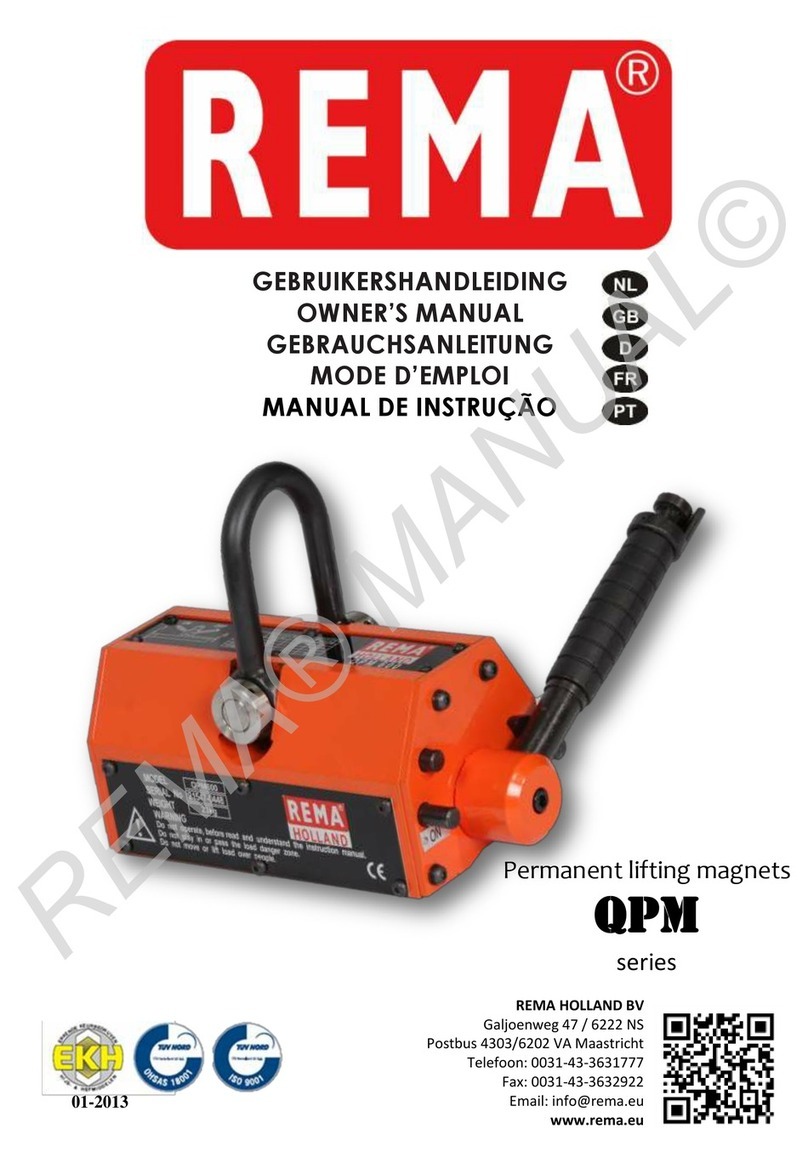Brano Z220-A User manual

BRANO a.s., 747 41 Hradec nad Moravicí
the Czech Republic
tel.: +420/ 553 632 303
http://www.brano-zz.cz; http://www.brano.eu
INSTRUCTION MANUAL
SAFETY PRINCIPLES, OPERATION AND MAINTENANCE
FOR
TRAVELLING CHAIN BLOCKS
type Z220
modification according to the width of the running profile
– A, – B, – C
design for potentially explosive atmospheres
–
NEXP
lifting capacities
0,5t; 1t; 1,6t; 3,2t; 5t; 7,5t; 10t; 15t and 20t
Read carefully this manual before using this product. This manual contains important
information on use, safety, installation, operation and maintenance of the product.
Make this manual available to all responsible persons.
Keep for f
urther use!
Edition 10
th
August 2020
Evidence number 1
-
56802
-
0
-
0

2
CONTENT
1 DEFINITION ...............................................................................................................................................3
2 DEVICE PURPOSE....................................................................................................................................3
3 SAFETY PRINCIPLES ...............................................................................................................................4
3.1 SAFETY SUMMARY...........................................................................................................................4
3.2 SAFETY PRINCIPLES........................................................................................................................4
3.2.1 Prior to use.......................................................................................................................................4
3.2.2 When in use .....................................................................................................................................5
3.2.3 After use ...........................................................................................................................................5
3.2.4 Risk analysis ....................................................................................................................................5
3.2.5 Maintenance.....................................................................................................................................5
4 PACKING, STORAGE AND MANIPULATION ...........................................................................................5
4.1 DELIVERY and PACKING ..................................................................................................................5
4.2 STORAGE...........................................................................................................................................6
4.3 MANIPULATION .................................................................................................................................6
5 MAIN TECHNICAL PARAMETERS ...........................................................................................................6
5.1 MECHANICAL CLASSIFICATION ....................................................................................................10
5.2 MATERIAL AND DESIGN.................................................................................................................10
5.3 DATA ON PRODUCT .......................................................................................................................11
6 INSTALLATION OF THE CHAIN BLOCK ................................................................................................11
6.1 CHECKING BEFORE THE INSTALLATION ....................................................................................11
6.1.1 Load carrying structure ..................................................................................................................11
6.1.2 (crane) trolley beam track ..............................................................................................................11
6.2 ASSEMBLY OF THE CHAIN BLOCK ...............................................................................................12
6.2.1 Condition for the correct travel of the trolley .................................................................................12
6.2.2 Installation onto trolley beam track of lifting capacities 0,5t and 1t................................................12
6.2.3 Installation onto trolley beam track of lifting capacities 1,6t; 3,2t; 5t; 7,5t and 10t.........................13
6.2.4 Installation onto trolley beam track of lifting capacities 15 and 20t................................................13
6.2.5 Lubrication of the chain ..................................................................................................................13
6.2.6 Checking of the chain position .......................................................................................................13
6.3 CHECK BEFORE USE .....................................................................................................................13
6.3.1 Setting of the hand chain ...............................................................................................................14
7 SERVICE AND OPERATION OF THE CHAIN BLOCK ...........................................................................14
7.1 USE OF THE CHAIN BLOCK ...........................................................................................................14
7.2 LIFTING, LOWERING.......................................................................................................................15
7.3 SAFETY WORKING ENVIRONMENT ..............................................................................................16
8 INSPECTION OF THE CHAIN BLOCK....................................................................................................16
8.1 INSPECTION ....................................................................................................................................16
8.1.1 Inspection classification .................................................................................................................16
8.1.2 Daily inspection ..............................................................................................................................17
8.1.3 Regular inspection .........................................................................................................................17
8.1.4 The chain block occasionally used ................................................................................................17
8.1.5 Inspection record............................................................................................................................17
8.2 INSPECTION PROCEDURE ............................................................................................................17
9 TROUBLE-SHOOTING ............................................................................................................................21
10 LUBRICATION .......................................................................................................................................21
10.1 GENERALLY...................................................................................................................................21
10.2 GEARINGS .....................................................................................................................................21
10.3 LOAD CHAIN ..................................................................................................................................22
11 MAINTENANCE .....................................................................................................................................22
11.1 SAFETY PRINCIPLES....................................................................................................................22
11.2 REPLACEMENT OF THE LOAD CHAIN........................................................................................22
11.2.1 Single fall chain ............................................................................................................................22
11.2.2 Multi-fall chain ..............................................................................................................................22
11.3 BRAKE ADJUSTMENT...................................................................................................................23
11.4 BEARINGS......................................................................................................................................23
11.5 GENERAL INSTRUCTIONS ...........................................................................................................23
11.6 CHECK............................................................................................................................................23
11.7 REPAIR ...........................................................................................................................................24
11.8 TEST ...............................................................................................................................................24
12 PUTTING OUT OF OPERATION – LIQUIDATION................................................................................24
13 RELATED DOCUMENTATION ..............................................................................................................24
14 FINAL REQUIREMENTS OF THE MANUFACTURER TO THE CUSTOMER......................................24

3
1 DEFINITION
! DANGER Danger: is used to indicate the presence of hazard, which will
cause death or severe injury, if the warning is ignored.
! WARNING Warning: is used to indicate a possible hazard, which could cause
death or severe injury, if the warning is ignored.
! CAUTION Caution: is used to indicate a possible hazard, which could cause
light injury, if the warning is ignored. Caution can warn against
dangerous practices as well.
Lifting capacity (Q): indicates the maximum permitted mass of a load (working load
limit), which a chain block is designed to support in general service under conditions
defined in this manual.
2 DEVICE PURPOSE
2.1 The travelling chain block type Z220
and designed for use in potentially explosive
atmospheres Z220-NEXP(hereinafter referred to as product or NEXP= structurally
identical product, differing in surface protection of selected parts, marking plate material
and documentation) of lifting capacities 0,5t, 1t, 1,6t, 3,2t, 5t, 7,5t, 10t, 15t, and 20t
(hereinafter referred to as „chain block“) has been designed solely for hand vertical
lifting, lowering and moving of free loads in working area of travel under normal
atmospheric conditions in the workplace. The load mass must not exceed the specified
nominal lifting capacity.
2.2 The product has been designed in compliance with the requirements stipulated by
Directive 2006/42/EC of the European Parliament and of the Council, as amended by
the Czech technical regulation – Government Directive No. 176/2008 Coll., as amended,
and the requirements of the
harmonized Czech technical standards ČSN EN ISO 12100
and ČSN EN 13157+A1.
2.3 The product has been designed in compliance with the requirements stipulated by
Directive 2014/34/EU of the European Parliament and of the Council, as amended by
the Czech technical regulation – Government Directive No. 116/2016 Coll., as amended.
The product has been designed as
IM2ExhIMb equipment pursuant to ČSN EN ISO
80079-36:2016 and ČSN EN ISO 80079-37:2016. It complies with the conditions
stipulated for use in mining environments classed as “hazardous atmospheric conditions
2” pursuant to ČSN EN 1127-2.
2.4 The product has been designed in compliance with the requirements stipulated by
Directive 2014/34/EU of the European Parliament and of the Council, as amended by
the Czech technical regulation – Government Directive No. 116/2016 Coll., as amended.
The product has been designed as II2GExhIIBT6Gb, II2DExhIIICT85°CDb
equipment pursuant to ČSN EN ISO 80079-36:2016 and ČSN EN ISO 80079-37:2016.
It complies with the conditions stipulated for use in environments classed as „zone 1 and
zone 21“, “ zone 2 and zone 22“ pursuant to ČSN EN 1127-1.
Note: Articles 2.3 and 2.4 apply to NEXP product design.

4
3 SAFETY PRINCIPLES
3.1 SAFETY SUMMARY
Danger exists when lifting and travelling with loads, particularly when the chain block is
not used properly or is poorly maintained. Since an accident or serious injury could
result, special safety precautions apply to the operation with the chain block during its
assembly, maintenance and inspection.
! WARNING
NEVER use chain block for lifting and transporting people.
NEVER lift or transport loads over or near people.
NEVER load the chain block more than the lifting capacity shown on the chain block
nameplate.
ALWAYS make sure the load carrying structure will provide adequate support to
handle fully loaded chain block and all the lifting operations.
ALWAYS let people around to know when a lift is about to begin.
ALWAYS read instruction manual and safety instructions.
Remember proper that
rigging, lifting and pulling techniques are the responsibility of
the operating staff. Therefore
check all applicable national directions, regulations and
standards for further information on the safety use of your chain block.
3.2 SAFETY PRINCIPLES
! WARNING
3.2.1 Prior to use
ALWAYS ensure, physically fit, qualified and instructed persons over 18 years of
age, familiarized with this manual and trained in safety conditions and
way of work, operate the chain block.
ALWAYS check the chain block daily before use according to the section 8.2.(1)
„Daily inspection“.
ALWAYS make sure the ends of track are fitted with the end stops.
ALWAYS make sure the track is free from any object.
ALWAYS make sure the length of chains is long enough for the intended job.
ALWAYS check the brake function of the chain block before use.
ALWAYS use original chain only.
ALWAYS ensure the load chain is not corroded, is cleaned and oiled.
ALWAYS make sure the last link of load chain is strongly fastened to the body.
NEVER use damaged or worn out chain block.
NEVER use chain block with jumped out, damaged or missing hook’s safety
latch.
NEVER connect or lengthen the load chain.
NEVER use a chain block without a visible marking of the lifting capacity.
NEVER use modified or deformed hooks.
NEVER use a chain block marked by the label „OUT OF OPERATION“.
ALWAYS consult the manufacturer or his authorized representative, if you plan to
use a chain block in non-standard or extreme environments.
ALWAYS check that the product is grounded through the ground terminal when working
in an explosive atmosphere
ALWAYS wipe off any dust before handling the product in an explosive atmosphere

5
3.2.2 When in use
ALWAYS make sure the load is properly seated in the hook.
ALWAYS make sure the safety latches of hooks work in the correct way.
ALWAYS pay attention to the limit positions.
ALWAYS use manual power only.
ALWAYS when lifting loads approaching the nominal lifting capacity of the lifting
device, we recommend, regarding the operating forces, the operation
was ensured by two persons.
NEVER use a chain block for tensioning, pulling or anchoring loads.
NEVER connect or lengthen the load chain.
NEVER allow swinging the load, causing impacts or vibrations.
NEVER use a chain as a sling.
NEVER load the chain block by diagonal pull.
NEVER hitch a load on the tip of the hook.
NEVER pull the chain over any edge.
NEVER weld, cut or make any operation on a suspended load.
NEVER use a chain as a welding electrode.
NEVER operate a chain block, if chain is jumping or atypical or
excessive noise occurs.
3.2.3 After use
NEVER leave a load suspended.
ALWAYS ensure the chain block against incompetent use.
3.2.4 Risk analysis
The analysis of possible risks in light of design, operation and environment of the chain
block application is presented in freestanding document „Risk analysis“. This document
can be required in service centers.
3.2.5 Maintenance
ALWAYS enable qualified persons inspect the chain block regularly.
ALWAYS ensure the chain was clean and oiled.
ALWAYS ensure the sliding parts were greased enough (except the brake).
NEVER add other parts for lengthening the load chain
Only such interventions can be done when maintaining that are in compliance with
requirements of the manufacturer specified in the chapters 11 and 14 of this manual.
IT IS NOT PERMISSIBLE to carry out repairs and maintenance in other way than
prescribed by the manufacturer. It concerns namely the forbiddance of using of
unoriginal spare parts or carrying out modifications on the product without an approval
of the manufacturer.
4 PACKING, STORAGE AND MANIPULATION
4.1 DELIVERY and PACKING
4.1.1 Travelling chain blocks are supplied free loaded on pallets wrapped in foil, trolley
and chain block separately. Chains are ensured against unfolding by the wire.
4.1.2 The following accompanying documentation is a part of the delivery:
a) Instruction Manual
b) EC Declaration of Conformity
c) Certificates of Quality and Completeness and Guarantee Card.
c1) Guarantee period is stated in the Guarantee Card.

6
c2) The guarantee does not apply to defects caused by infringement of the
instructions stated in this Instruction Manual and defects occurred owing to
improper use and unskilled intervention.
c3) The guarantee does not apply also to modifications on the product or using
of unoriginal spare parts without an approval of the manufacturer.
c4) A claim for defects in the product must be applied according to the relevant
provisions of the Commercial Code or the Civil Code, as amended.
d) List of service centers (for the Czech and Slovak Republics only).
4.2 STORAGE
Store the traveling chain blocks in dry and clean stocks free from chemical influences
and vapours.
(1) Always store the chain block without any suspended load.
(2) Remove all dust, water and impurities from the chain block.
(3) Lubricate chain, pivots of pulley, pivots of hook and spring of safety latch of hook.
(4) Store the chain block in a dry place.
(5) During further use follow instructions of the article No. 8.1.2 „Daily inspection” or
8.1.4 „The traveling chain block occasionally used“.
4.3 MANIPULATION
During transportation and manipulation follow the applicable technical regulations and
standards for work with heavy loads.
5 MAIN TECHNICAL PARAMETERS
LIFTING CAPACITIES 0,5t; 1t; 1,6t; 3,2t and 5t
Table 5.A - Technical parameters
Type
Lifting
capacity
(t)
Number of
load chain
falls
Chain ČSN
EN 818-7
(strength
class 8)
Operating
force for
travel
(N)
Operating
force for lift
(N)
Travel
1)
speed
(m/min)
Lifting
1)
speed
(m/min)
Range of
operating
temperature
Lift (m)
Weight
(kg)
Z220-A
0,5
1
∅5x15 250 300 4,8 1,1
-20°C
Up to
+50°C
3
16,9
Z220-B
18,6
Z220-C
19,6
Z220-A
1 ∅7x21 250 350 4,8 0,7
22,4
Z220-B
24,1
Z220-C
25,1
Z220-A
1,6 ∅9x27 150 320 2,25 0,36
44,4
Z220-B
46,2
Z220-C
47,4
Z220-A
3,2
∅11x31
280 400 2,3 0,29
73,1
Z220-B
74,9
Z220-C
76,6
Z220-A
5 2 350 400 1,8 0,145
105,5
Z220-B
107,5
Z220-C
110,8
Notes:
1) Calculated on presumption of winding off 30m of the hand chain per minute.
2) Maximum standard lift is 15m. Required lift is necessary to be specified in the order.
Lifts exceeding 15 m must be consulted with the manufacturer.

7
Table 5.B - Dimensions
Type Lifting
capacity (t)
Main dimensions – informative
(mm)
I – beam
( I, IPE, HEA, HE
B, HEM )
a d d
1
D e
min
L
min
r E b
R
Z220-A
0,5
Is notsuitable
for the profile
HEM
245
30 55 108
18,5
290
87
89 - 144 58 - 113
1000
Z220-B 89 - 253
58 - 226
(IPE, HEA, HEB)
58 - 155
( I - diagonal
flange)
Z220-C 199 - 327
125 - 300
(IPE, HEA, HEB)
125 - 155
( I - diagonal
flange)
Z220-A
1
Is notsuitable
for the profile
HEM
245
36 55 108
23,5
340
87
89 -144 58 - 113
1000
Z220-B 89 -253
58 - 226
(IPE, HEA, HEB)
58 - 155
( I - diagonal
flange)
Z220-C 199 - 327
125 - 300
(IPE, HEA, HEB)
125 - 155
( I – diagonal
flange)
Z220-A
1,6 350
43 100
230
29,5
457
140
148 - 172
58 - 113
1700Z220-B 148 - 284
58 - 226
Z220-C 227 - 358
137 - 300
Z220-A
3,2 435
50 133
280
35,5
515
170
168 - 187
82 - 125
2500Z220-B 168 - 288
82 - 226
Z220-C 246 - 362
160 - 300
Z220-A
5 505
56 148
345
39,5
660
218
183 - 214
90 - 137
2800
Z220-B 183 - 304
90 - 226
Z220-C 263 - 378
170 - 300

8
Travelling chain blocks with great length of lift can be equipped upon special request
with a chain container
LIFTING CAPACITIES 7,5t and 10t
Table 5.C - Technical parameters
Type
Lifting
capacity
(t)
Number of
load chain
falls
Chain ČSN
EN 818-7
(strength
class 8)
Operating
power for
travel
(N)
Operating
power for lift
(N)
Lifting
1)
speed
(m/min)
Range of
operating
temperatu
re
Lift (m) Weight
(kg)
Z220 7,5 2
∅11x31
500 480 0,15 -20°C
up to
+50°C
3
207,2
Z220-C
211,2
Z220 10 3 500 390 0,1 264,5
Z220-C
272
Notes:
1) Calculated under presumption of unwinding 30m of hand chain per minute.
2) Maximum standard lift is 15m. The required lift is necessary to be specified in the order.
Lifts over 15 m must be consulted with the manufacturer.
Table 5.D - Dimensionsy
Type
Lifting
capacity
(t)
Main dimensions – informative (mm) I – beam
( I, IPE, HEA, HEB, HEM )
a d d
1
D e
min
L
min
r E b R
Z220 7,5 685
56 196 345
43 875
300
242 - 314 125 - 185 5000
Z220-C 263 - 429 146 - 300
Z220 10 765
63 228 428
47 920
328
259 – 327 125 - 185 9000
Z220-C 314 - 442 180 - 300
Travelling chain blocks with great length of lift can be equipped upon special request
with a chain container.

9
LOAD CAPACITIES 15t and 20t
Table 5.E - Technical parameters
Type
Lifting capacity
(t)
Number of load
chain falls
Chain
ČSN
EN 818-7
(strength
class 8)
Operating
power for travel
(N)
Operating
power for lift
(N)
Lifting
1)
speed
(m/min)
Range of
operating
temperat
ure
Lift
2)
max.
(m)
Weight
without
chain
(kg)
Increase in
weight per
1m of lift
(kg)
Z220
15 4
∅11x31
500 480 0,15 -20°C
to
+50°C
12 285 13
20 6 500 400 0,1 8 345 19,2
Notes:
1) Calculated under presumption of unwinding 30m of hand chain per minute on each chain block.
2) Lift according to the order. Lifts over the values stated in the table must be consulted with the
manufacturer.
Table 5.F - Dimensions
Lifting
capacity
(t)
Main dimension – informative (mm)
a d d
1
D r f e
min
L
min
15 1290 71 196 375 300
270 50 780
20 1500 80 237 428 328
380 62 720
Travelling chain blocks of lifting capacities 15 and 20t are usually equipped with chain
containers and are designated just for assembly to beams with flat flange. The
possibility of track curving is not supposed.
b= width of beam’s flange
sets the customer, when
placing the order for
travelling chain block

10
5.1 MECHANICAL CLASSIFICATION
Safety and life of the travelling chain block is guaranteed under presumption it works in
accordance with the specified classification. The travelling chain block is designed for
the class 1Bm according to the regulation FEM 9.511 – see TABLE 5.1. (conforms to
classification of the mechanism M3 according to the ISO 4301/1).
Average daily operating time is set by loading diagram.
Tab. 5.1 MECHANICAL CLASSIFICATION
Load spectrum diagram
(load distribution)
Definition Cubic mean
value
Average daily
operating time (h)
1
(light)
Travelling chain blocks
usually subject to very
small loads and in
exceptional cases only to
maximum loads.
k≤0,50 1 - 2
2
(medium)
Travelling chain blocks
usually subject to small
loads but rather often to
maximum loads.
0,50< k ≤0,63 0,5 - 1
3
(heavy)
Travelling chain blocks are
usually subject to medium
loads but frequently to
maximum loads.
0,63< k ≤0,80 0,25 – 0,5
4
(very heavy)
Travelling chain blocks are
usually subject to maximum
or almost maximum loads.
0,80< k ≤1,00 0,12 – 0,25
Load spectrum Load spectrum Load spectrum Load spectrum
1 2 3 4
% pracovního času
% operating time
5.2 MATERIAL AND DESIGN
5.2.1 Main parts of the chain block are manufactured from steel and cast iron, braking
inserts of brake from brass or ceramic-metallic material.
5.2.2. Materials inclinable to creation of an incendiary spark in terms of the annex No. 2
article 1.3.1 to the ministerial order No. 116/2016 of the Coll. of Laws and the ČSN
EN 1127-2 article 6.4.4 and ČSN EN ISO 80079-36 article 6.4.2.1 harmonized
technical standards are not used.
5.2.3 Materials with dangerous effects of static electricity within the meaning of the ČSN
EN 1127-2 article 6.4.7, ČSN EN ISO 80079-36 article 6.7 and ČSN 33 2030 are
not used in the chain block.
5.2.4 The chain block does not exceed the noise values specified in the annex 1 article
1.7.4.2 letter u of the MO No. 176/2008 of the Coll. of Laws (EP and RE directive
No. 2006/42/EC)
Note: Articles 5.2.2 and 5.2.3 apply
to NEXP product design.

5.3 DATA ON PRODUCT
Every product is fitted with label with specified data as follows:
Standard design:
N
EXP
p
roduct
d
esign
:
Manufacturer’s identification
Manufacturer’s identification
Address of the manufacturer
Address of the manufacturer
Type of product
Type of product
Lift
ing capacity
Lifting capacity
Serial number
Serial numbe
r
Year of production
Year of production
CE marking
CE marking
sign of protection type (I IM2ExhIMb for group I,
II2G
Ex
hIIB
T
6Gb,
II2
D
Ex
h
I
II
C
T
85
°C
Db
for group
II)
6 INSTALLATION OF THE CHAIN BLOCK
6.1 CHECKING BEFORE THE INSTALLATION
Prior to installation check the chain block for possible damages.
The NEXP product must be installed in such a way as to prevent creeping charges.
Charging mechanisms stronger than manual friction must be avoided at the installation
site.
A NEXP product when used in a mine or other environment where the product could
collide with falling, flying… objects (rock, stones…) must be protected to minimize the
likelihood of a collision (sufficiently dimensioned cover, …).
6.1.1 Load carrying structure
The (crane) trolley beam track and related load carrying structure (parts of buildings,
etc.) determined for operation of the travelling chain block shall be supported by
drawings and static calculation.
! WARNING
ALWAYS
make sure the trolley beam track and related load carrying structure is firm
enough to support the weight of the load and the travelling chain block.
The installation must not be provided onto the structure, where carrying
capacity cannot be checked.
ALWAYS make sure the ends of travel rail are fitted with end stops.
ALWAYS make sure the flatness of the trolley beam track is kept.
ALWAYS the user is responsible for the load carrying structure!
6.1.2 (crane) trolley beam track
! CAUTION
The travelling chain block can be installed to beams with inclination of the lower flange
to 20% or with a straight flange. At lifting capacities 15 and 20t only to the straight
flange.
Range of width of lower flange of beam (b) and minimum radius of curve of the trolley
beam track (R) for particular lifting capacities are mentioned in the table 5 - Dimensions.
At lifting capacities 15 and 20t the curve of the trolley beam track is not permitted.

12
! WARNING
The permissible maximum deflection of the trolley beam track from loading by own mass
and nominal loading capacity is 1/500 of distance between suspending (supports).
Permitted maximum gradient of running surface is 0,3%.
Maximum height of the trolley beam track above the floor is 20m. An application of the
chain block on higher trolley beam tracks is necessary to be consulted with the
manufacturer.
6.2 ASSEMBLY OF THE CHAIN BLOCK
! CAUTION
Be careful during suspending the chain block on the suspension element and ensure
appropriate conditions for safety installation according to the character of the
environment (working platform, auxiliary lifting device, etc.) to avoid endanger or injury
of people. Use safety equipment, when suspending the chain block in heights to avoid
fall from heights.
User is responsible for creating conditions for installations and providing installation of the chain block.
! WARNING
Assembly of the chain block of lifting capacities 7,5t and 10t can be provided only
by qualified persons.
User is responsible for creating conditions for assembly and providing assembly
of the chain block.
Assembly of the chain block of lifting capacities 15t a 20t can be provided only by
specialized factory-authorized firm.
6.2.1 Condition for the correct travel of the trolley
A) Tolerance (x) between tyres of travelling wheels and
flange of beam shall be approximately 2 mm. For
curvature tracks the tolerance must be increased
adequately.
B) Suspension shackle of the trolley must be in the
centre of the beam.
C) Attachment bolts (at capacities 1,6 – 10t) place to
centres of openings in sides in such a way, the
condition of tolerance between the bolt and lower flange
of beam was 3 - 6mm was fulfilled.
6.2.2 Installation onto trolley beam track of lifting capacities 0,5t and 1t
1) Remove the retaining rings from the crossbar, remove distance washers and pull out
the crossbar from side plates of the trolley. This will cause disconnection between
the chain block and trolley. Take off distance washers and lifting loop with the chain
block.
2) Put on the lower flange of I – beam side plate with geared wheels and hand chain
wheel and ensure against the possible fall.
3) Insert the crossbeam into side plate bushing and ensure by the cotter pin.
4) Set on the crossbeam the relevant number of distance washers so that the chain
block was placed in axe of the beam and the condition for the correct function was
thus fulfilled according to the 6.3.1.
5) Set on the crossbeam the lifting loop with the chain block.
xx

13
6) The same number of distance washers set on the other side of the lifting loop
(sheave fork).
7) Put on the lower flange of I – beam the other side plate and set on the cross beam
all remaining distance washers and ensure by cotter pin.
8) Stretch ends of both cotter pins so that they cannot fall out. Straighten hand chain
and test rail of travelling chain block without the load.
6.2.3 Installation onto trolley beam track of lifting capacities 1,6t; 3,2t; 5t; 7,5t and
10t
1) Remove the cotter pins from the crossbeam, take off the distance washers and move
the cross beam out of the side plates of the trolley. Thus you disconnect the chain
block and trolley. Take off the distance washers and lifting loop with the chain block.
2) Screw off outer nuts of distance bolts of the trolley and dismantle side plate of trolley
on side without geared wheels.
3) Put on the lower flange of I – beam the side plate with geared wheels and hand
chain wheel and ensure against the possible fall.
4) Put the other side plate of the trolley on the flange of beam and distance bolts and
ensure with nuts of the distance bolts to prevent fall of the trolley from the beam.
5) Insert the crossbeam into side plate bushing with plain wheels.
6) Set on the crossbeam the relevant number of distance washers so that the chain
block is placed in axe of the beam and the condition for the correct function was thus
fulfilled according to the 6.3.1.
7) Set on the crossbeam the lifting loop with the chain block.
8) The same number of distance washers set on the other side of the sheave fork.
9) Put the crossbeam into bushing of the other side plate and ensure by the cotter pin.
10)All remaining distance washers put on the crossbeam out of the side plate with plain
wheels and ensure by cotter pin.
11)Stretch ends of both cotter pins so that they cannot fall out once.
Straighten hand chain and test the rail without the load.
6.2.4 Installation onto trolley beam track of lifting capacities 15 and 20t
The installation requires special assembly jigs and can be performed only by a
specialized factory-authorized firm.
6.2.5 Lubrication of the chain
Put the thin layer of oil on the chain preferably by means of a spray. Regular lubrication
will avoid wear and corrosion of the chain and lengthen its life.
6.2.6 Checking of the chain position
Check, whether the hook is not turned over and chain kinked or twisted as illustrated in
the pictures 1 and 2. If the chain is kinked, return it to the correct position. Never
suspend load onto kinked or twisted chain. Chain is not kinked, if the welded parts of
links are in one row.
It applies for lifting capacities 5t and more. Pay increased attention to checking of the
chain position of lifting capacities 15 and 20t.
6.3 CHECK BEFORE USE
CHAIN MUST BE
STRAIGHTEN SO THAT
THE LUGS AFTER
WELDING WERE ON
ONE SIDE ONLY
Pic. 1 Kinked chain
TURNING OVER
THE PULLEY
CAUSE TWISTING
OF THE CHAIN. BY
ITS TAKING BACK
THE CHAIN IS
STRAIGHTENED
Pic. 2 Chain twisting

14
Lift
6.3.1 Setting of the hand chain
After the installation of the chain block in the
workplace we check the position of the hand chain.
The distance of the end of bottom loop of the hand
chain over the level of the surface, on which operation
staff of the chain block stands during the operation,
must be in the range 500 –1000mm. Chain blocks are
supplied with hand chains, the length of which is
proportional to the lift of the chain block and during the
standard installation meets condition of correct setting
of the chain end.
In other cases, where regarding the way of use of the
chain block, the length of the hand chain does not
meet prescribed conditions, the chain must be
shortened or lengthened.
Shortening of the chain: we disconnect the chain in
place of the coupling link by buckling free ends of the
links. We shorten the chain by required length and
connect again by coupling link. Free ends of the
coupling link we bend to one another.
Lengthening of the chain: we disconnect the chain in
place of the coupling link by buckling free ends of the
links. We attach other part of chain of required length
by means of two coupling links. Free ends of coupling
links we bend to one another.
Coupling links and hand chain of required length can
be bought as spare parts.
Note: the requirement for hang chain of other length
than standard one can be given just in the order.
! CAUTION
(1) First see again through the previous articles of this manual and make sure all steps
were correctly done and all parts are safely assembled.
(2) Check over visually, whether the load carrying structure or pendant elements are
without defects.
(3) By pulling the hand chain of the chain block check the function of the travelling chain
block without any load.
(4) By pulling the hand chain of the trolley check the travel of the chain block.
(5) Provide several lifting and lowering with a suitable load (10% to 50% of lifting
capacity). At the same time, check the brake, whether it holds the load without
slipping during lowering and stopping.
7 SERVICE AND OPERATION OF THE CHAIN BLOCK
7.1 USE OF THE CHAIN BLOCK
The travelling chain block is the multipurpose device, determined for lifting and lowering
of loads and horizontal movement of loads in working space of the crane track under
normal atmospheric conditions in the workplace and in environments with an explosive
risk as well, if there is a symbol of the protection type on the label – see articles 2.3 and
2.4 of this instruction manual.

15
It is operated by means of hand chains. It is determined for organisations and private
persons as well.
When installed outside, protect the chain block against the direct climatic influences.
! WARNING
Since work with heavy loads may present an unexpected danger, it is necessary to
follow all the “Safety instructions” according to the chapter 3.
! WARNING
The last link of the load chain is anchored on the body of the traveling chain block. The
anchorage just prevents against release of the load chain and is not determined for
holding load.
Do not continue to work if tensioning of the anchored end of the load chain takes place.
Any damage of the anchorage can cause fall of the load.
! WARNING
The covers of the hoist body are not sufficiently dimensioned in terms of "breakthrough",
therefore any covers that could cause a collision with the gears must be repaired or
replaced. If it happens that the product has a collision with a falling, flying object (rock
slide) that could sufficiently damage the covers, work must be stopped immediately and
the product inspected.
7.2 LIFTING, LOWERING
Lifting and lowering is provided by pulling the hand chain of the chain block. Lifting and
lowering can be interrupted in any height of lift.
! WARNING
At chain blocks with a great lift (15 m and more) a danger of heating of the brake can
happen when lowering load in exceptional cases (uninterrupted and quick lowering). In
such cases it is necessary to lower loads slowly and step-wise).
! CAUTION
When lifting loads that will be in the lifted state hanged over to other lifting device
(crane, lift truck etc.) it is necessary to relieve the load chain (chains) of the chain block
by means of the hand chain, not by lifting load by means of the other lifting device. Just
defined procedure guarantees the trouble free release of the brake of the chain block
after taking of the load.
! WARNING
Travelling chain blocks of lifting
capacities 15t and 20t are
determined for multimember
operating staff. Speed of
unwinding of chain during lifting or
lowering has
to be the same on both chain
blocks – synchronised so that the
same length of chain remain in
both containers. The operating
staff must check straightening of
colour marked parts of the central
part of the chain on the block
(Z220/20t) or at the top pulley
(Z220/15t) - see pic. 7.2.
Z220/20t
Pic. 7.2
Z220/15t

16
7.3 SAFETY WORKING ENVIRONMENT
! WARNING
(1) The operating staff must be demonstrably familiarized with this manual, must follow
safety and hygienic regulations and must be authorized to the operation of this
equipment.
(2) The operating staff must be equipped with helmet, gloves and suitable footwear.
(3) Only verified binding means of appropriate lifting capacity are to be used for binding
loads.
(4) When more persons take part in the operation, only one of them must be determined
who is trained in safety work instructions and responsible for manipulation with the
travelling chain block.
(5) He must have a clear and unobstructed view of the working area before starting the
work. When it is not possible, one or more persons must help to supervise in the
nearby area of the chain block.
(6) The operating staff must check, whether the entire work place is safe and whether
there is a possibility of escaping from this area in case of endanger, before starting
to operate the chain block.
(7) The free space for the operating staff shall be ensured when using the travel of the
chain block.
(8) During the work with the chain block the suitable distance of the operating staff from
the load must be kept. It is prohibited to lift or lower bulky loads preventing to keep
sufficient distance.
(9) When operating the chain block in limited areas you must prevent the hook or load
would not hit into obstacles or to the chain block body.
8 INSPECTION OF THE CHAIN BLOCK
8.1 INSPECTION
8.1.1 Inspection classification
(1) Initial inspection: it precedes prior to initial use. All new or repaired travelling chain
blocks shall be inspected by a designated qualified person to ensure qualified
compliance with the applicable provisions of this manual.
(2) Inspections of chain blocks in regular service are generally divided into two
classifications according to intervals at which should be performed. The intervals
depend upon the nature of the critical components of the chain block and the degree of
their exposure to wear, deterioration or malfunction. The two general classifications are
herein designated as daily and regular. The respective intervals are defined as follows:
(a) Daily inspection: visual inspection provided by the operating staff designed by the
user at the beginning of each usage.
(b) Regular inspection: visual inspection provided by the qualified person designated
by the user.
1) normal operation – annually,
2) heavy operation – twice per year,
3) special or infrequent operation – as recommended by a qualified person at first usage
and according to the directions of the qualified employees (maintenance workers).

17
8.1.2 Daily inspection
Check, at parts such as those listed in section 8.2(1) “Daily inspection”, whether chain
blocks are not damaged or are without any defect. Provide this inspection also during
the operation in the interval between regular inspections. Qualified employees shall
determine, whether any defect or damage can constitute a hazard or more detailed
inspection is required.
8.1.3 Regular inspection
Complete inspections of the travelling chain block perform as recommended regular
inspections. These inspections may be performed with the travelling chain block in its
normal location and do not require dismantling the chain block. The recommended
regular inspection defined in the section 8.2(2) shall be performed under the supervision
of competent persons who determine, whether the complete disassembly is necessary.
These inspections shall include the requirements of the daily inspection as well.
8.1.4 The chain block occasionally used
(1) The chain block that has been idle for a period of one month or more but less than
one year shall be put through a detailed inspection conforming to the requirements of
the section 8.1.2 before it is placed again in operation.
(2) The chain block that has been idle for a period of one year shall be put through a
detailed inspection conforming to the requirements of section 8.1.3 before it is placed
again in operation.
8.1.5 Inspection record
Always keep the record on the performed tests, repairs, inspections and maintenance of
travelling chain blocks. Dated inspection records should be performed at time intervals
specified in sections 8.1.1 (2) (b) and such records are stored available in the place
designated by the user. Defects found by the inspection or recorded during the
operation must be announced to the person responsible for safety and designated by
the user.
8.2 INSPECTION PROCEDURE
(1) Daily inspection (provided by the operating staff or competent person)
PART INSPECTION
METHOD
LIMIT/CRITERIA
FOR DISCARD REMEDY
1. Function of chain
block.
Visually, by listening.
Chain binds, jumps,
make an excessive
noise, etc.
Clean and lubricate
the chain, if the
problem is not solved,
replace the chain.
2. Fastening parts. Visual check of all
bolts, nuts, rivets etc.
Defective or missing
parts.
Released parts.
Replace by new ones.
Tighten released
parts.

18
3. Hooks
(1) Appearance
(2) Hook rotation
(3) Safety latch
Visually.
Turn the hook around
its axis.
Manual springing of
safety latch
Safety latch jump out
from the hook top.
Bent shank of the
hook, other visible
hook deformations.
Hook does not rotate
fluently or scrub.
Safety latch does not
return after pushing
Professional
inspection of lifting
device – replacing the
hook and other
damaged parts.
Clean and lubricate.
Clean, lubricate,
repair or replacement
4. Load chain
(1) Appearance
Check visually the
whole chain.
Cracks in the place of
welding, deformation,
excessive wear,
corrosion.
Chain replacement.
Note:
The complete wear of
the chain cannot be
determined by the
visual inspection.
When wear sign is
found check the chain
according to “Regular
inspection”.
(2) Lubrication
(3) Setting of chain
(4) Overturning of
pulley (valid only
for two strand
models).
Visually
Visual inspection
according to the
picture 1, whether the
chain is not twisted.
Visually according to
the picture 2.
The chain is not
lubricated.
Chain is turned over
or twisted, welds are
not in line.
Chain is twisted by
overturning of pulley,
welds are not in line.
Clean and lubricate
the chain.
Straight up the chain
and set to normal
position.
Straight up the chain
by overreturning the
pulley to the correct
position.
5. Hand chain
Visually Chain is overturned or
twisted.
Chain is deformed or
damaged and do not
enter correctly the
chain wheel.
Straight up the chain
and set it to normal
position.
Replace the chain.
6. Trolley side plate
Visually Visible deformation
of the side plate.
Replace of the side
plate.
Wear in this part
Welded part
Diameter

19
(2) Regular inspection (provided by qualified person)
PART INSPECTION
METHOD
LIMIT/CRITERIA
FOR DISCARD REMEDY
1. Fastening parts.
Visual check of all
bolts, nuts, rivets,
etc.
Defective or missing
parts.
Released parts.
Replace by new ones.
Fasten released parts.
2. All parts Visual check. Worn or damaged
parts.
Dirty and non
lubricated parts.
Replace by new ones.
Dismount, clean,
lubricate and
assemble again.
3. Name plate –
marking of the lifting
capacity on the chain
block
Visual check Lifting capacity is
illegible
Repair or replace by
the new one.
Repair marking on the
chain block.
4. Hooks
(1) Deformation of
hook (opening)
(2) Wear of hook
Measure dimension
„C“ by slide calliper.
Visual check.
Measure dimension
„A“ and „B“ by slide
calliper.
Measured value is
higher than set by
table.
Deformation is visible
during visual check.
Do not use hook.,
if the dimensions
„A“ or „B“ get
smaller about more
than 10%.
Qualified check of
lifting device –
replacement of hooks
and other damaged
parts.
Replace worn out or
deformed hook by a
new one.
5. Chain - elongation
- colour marking
(applicable for 15 and
20t)
Pitch measuring by
slide calliper,
measure in place,
where the contact
with pulley and nut
is the most frequent.
Visual check.
Dimensions „p“ must
not exceed limit
values mentioned in
the following table.
Colour is not visible
If limit criteria are
exceeded ask for
replacing the chain.
Paint the center of the
chain with red colour
in the length about
600 mm
Standard Lim it Standard Lim it
0,5 17,5 15,8 16 14,5
1 22 19,8 19 17
1,6 26 23,4 23 20
3,2 36,5 32,8 34 30,5
5 42 37,8 35 31,5
7,5 48 43,2 38 34,2
10 58 52,2 45 40,5
15 67 60,3 53
47.7
20 75 67,5 60 54
59
66
Capacity
( t )
Dim ension"A" (m m ) Dim ension "B " (m m ) Dim ension "C" (m m )
Lim it
52
47
24
35
41
45
29

20
6. Brake - function Suspend the load equal
to nominal lifting
capacity; lift it at min.
by 250 mm and lower
down.
After interrupting the
operation, the brake
must keep the load in
any position of lifting
or lowering.
If it does not happen,
ask for repairing and
adjusting the brake.
7. Anchoring the
chain.
Visual check. The end of the chain
is not fastened to the
body enough..
Fasten the fixing
screw; repair the
damaged joint or
replace.
8. Pawl - function Visual check during
lifting.
Pawl does not snap to
ratchet wheel teeth.
Clean, lubricate or
replace the spring.
9. Block sheave
rotating (at lifting
capacity 7,5t)
Rotate with block
sheave by pulling the
chain.
Block sheave does not
rotate fluently.
Clean, lubricate or
repair.
10. Side plate
Visual check
Visual deformation of
slide plates.
Revision of the
hoister; putting out of
operation
11. Travel of
trolley
Visual check Failure of the
condition 6.3.1
Set up the travel.
12. Deformation
and wear of
crossbeam and load
bar
Visual check or check
by means of slide
calliper
Curved or worn out
crossbeam or load bar
more than by 10%
Revision of the
hoister,
discard.
ppppp
Standart Limit
∅55 75 77,3 4,5
∅75 105 108,2 6,3
∅95 135 139,1 8,1
∅11 5 155 159,7 9,9
Chain size
(d)
Number of
measured
linksů
Pitch of measured linksů
p x 5
Discard limit
for (
d )
This manual suits for next models
2
Table of contents
Other Brano Lifting System manuals
Popular Lifting System manuals by other brands

Hy-Brid Lifts
Hy-Brid Lifts HB-830 MAINTENANCE & TROUBLESHOOTING MANUAL
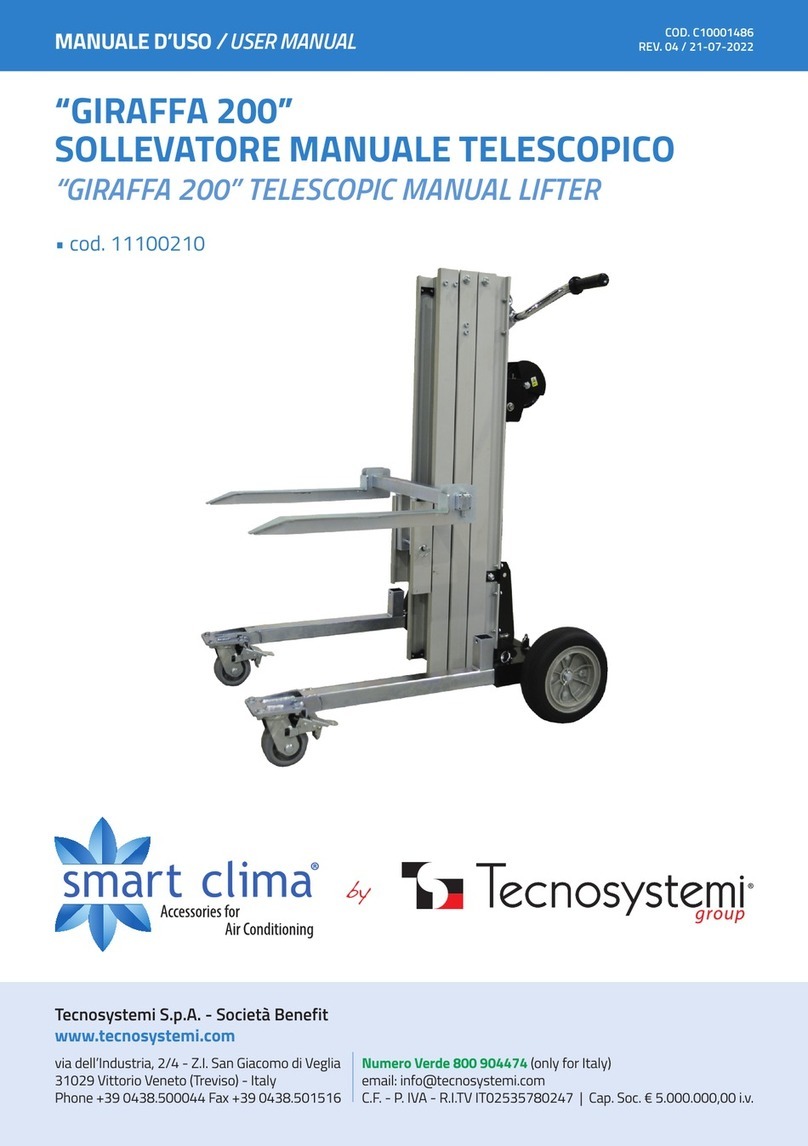
Tecnosystemi
Tecnosystemi smart clima GIRAFFA 200 user manual

Ingersoll-Rand
Ingersoll-Rand BHD15 instruction manual
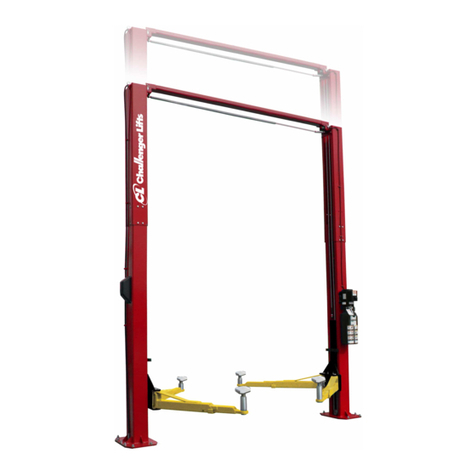
Challenger Lifts
Challenger Lifts LE12 Installation, operation & maintenance manual

morse
morse 400A-96SS-114 Operator's manual
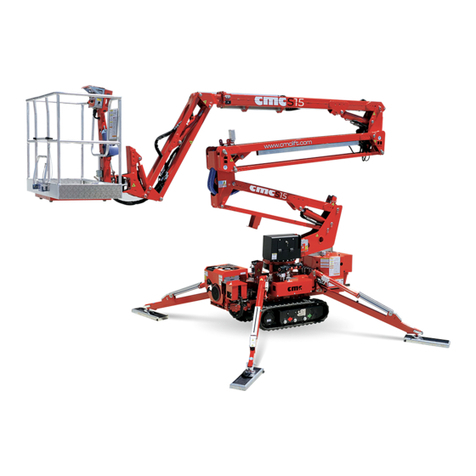
CMC
CMC SUP15 manual

